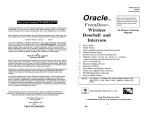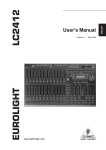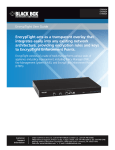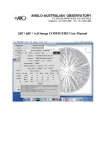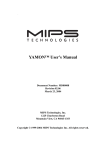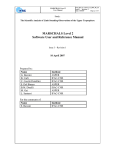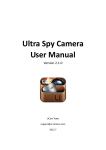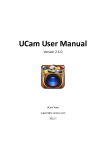Download UCam Installation Manual
Transcript
UCam Installation Manual
Version 0.3
Stewart McLay
5th March 2010
Acknowledgements
Professor Vikram Dhillon who was P.I. for the UltraCam
instrument the project from which UCam was born.
The UCam development team has involved several members
of UK ATC staff. Valuable contributions were made by:
David Atkinson, Steven Beard, Derek Ives,
Stewart McLay, Chris Tierney and Andy Vick.
The Enhanced Machine Controller (EMC) project for their
knowledge base wiki which has been a valuable source of
information for installing RTAI on Debian Linux.
2
Table of Contents
1Introduction........................................................................................................................................5
1.1About UltraCam..........................................................................................................................5
1.2About ARC Controller................................................................................................................5
1.3About UK Astronomy Technology Centre.................................................................................6
1.4Acronyms And Abbreviations.....................................................................................................6
1.5Stylistic Conventions..................................................................................................................6
2How To Install Debian Linux.............................................................................................................8
2.1Debian Releases..........................................................................................................................8
2.2Installing Debian Linux Using The Network Installer...............................................................8
3How To Install RTAI Real-Time Linux............................................................................................11
3.1How To Do A Quick Real-Time Linux Installation..................................................................11
3.2How To Do A Full Real-Time Linux Installation.....................................................................11
3.2.1Installing Essential Debian packages................................................................................11
3.2.2Get The Source Files.........................................................................................................12
3.2.3Apply Patches To The Kernel Source Files......................................................................13
3.2.4Fix Linux Kernel and GCC Compiler Compatibility Problem.........................................13
3.2.4.1Configuring Older Versions Of GCC Compilers (Linux Kernel V2.6.21 or less)....13
3.2.4.2Modifying Linux Kernel Build Flags (Linux Kernel V2.6.22 or greater).................14
3.2.5Configuring The Linux Kernel..........................................................................................14
3.2.6Compiling The Linux Kernel (and creating Debian kernel packages).............................15
3.2.7Installing The Linux Real-Time Kernel............................................................................15
3.2.8Compiling And Installing RTAI Modules.........................................................................16
3.2.9Installing The RTAI Real-Time Kernel Modules..............................................................16
3.3Testing RTAI Real-Time Linux................................................................................................17
4How To Install UCam.......................................................................................................................18
4.1Installing Third-Party Libraries................................................................................................18
4.2Building UCam Software..........................................................................................................18
4.2.1Building UCam From The Repository..............................................................................18
4.2.2Building UCam From A Tarball........................................................................................18
4.3Installing UCam........................................................................................................................19
4.3.1Setting Up The RTAI Environment Using The Installation Script...................................19
4.3.2Setting Up The RTAI Environment Manually..................................................................19
4.4Starting Up UCam....................................................................................................................20
5How To Install PyUCam and WxUCam...........................................................................................22
6How To Install Meinberg GPS.........................................................................................................23
6.1Hardware Set-up.......................................................................................................................23
6.2Preparing the Kernel Sources...................................................................................................23
6.3Building And Installing The Meinberg GPS Driver ................................................................23
6.4Rebuild UCam With Meinberg GPS Support...........................................................................24
7Trouble Shooting And Other Tips....................................................................................................25
7.1Checking The Memory Usage..................................................................................................25
7.2Checking The RTAI Environment............................................................................................25
7.2.1Checking RTAI Modules...................................................................................................25
7.2.2Checking RTAI Device Nodes..........................................................................................25
7.2.3Checking RTAI Boot Script Installation...........................................................................26
7.2.4Restarting the RTAI Environment.....................................................................................26
7.3Checking The UCam Servers Are Alive...................................................................................26
7.4Monitoring Processes................................................................................................................26
3
7.5Debian Administration..............................................................................................................27
7.5.1Debian Software Updates..................................................................................................27
7.5.2Debian Package Management...........................................................................................27
7.5.3Debian Language Packs....................................................................................................27
7.5.4Managing User Accounts..................................................................................................27
7.6Disabling Intelligent Platform Management Interface (IPMI).................................................28
7.7Mounting A Remote File System Using SSHFS......................................................................28
8Useful Web Pages.............................................................................................................................30
9Appendix A.......................................................................................................................................31
4
1 Introduction
The UCam software is a camera controller and data acquisition application. It is developed for use
on camera systems as part of astronomical research instrumentation and is presently in use at some
of the leading telescopes in the world today. UCam was originally developed for the UltraCam
instrument which is a high temporal resolution triple-beam CCD camera and has subsequently been
used on the WFCAM instrument which is a wide field infra-red survey camera. These are just two
examples of the wide diversity of astronomical instrumentation that UCam can support but there are
others.
The UCam software is primarily designed to make full use of the ARC controller as developed by
Astronomical Research Cameras. Although it is a highly configurable system and may be adapted in
the future for use with other camera controllers. The UCam design model is application centric
where different applications tailored for specific detectors and readout modes are downloaded and
executed on the camera controller hardware. This highly configurable application centric design is
what has enabled UCam to be an adaptable and reusable solution for several astronomical
instruments.
UCam runs on a real-time Linux operating system so it is able to provide fast imaging capabilities
for instrumentation where it is needed. It is also designed to be a server application so it can be
installed and used remotely across a network running on a standard Linux operating system. At
present UCam supports the HTTP protocol and uses the XML format for sending data packets. The
interface is simple enough to be accessible through a web browser and there are several client GUI
applications and software libraries available for interfacing with the UCam server.
This document described how to install a UCam software system. This includes how to install the
real-time Linux operating system and all the necessary software packages required to install and run
the UCam system. The intended audience for this document are technical staff who are responsible
for installing and maintaining camera data acquisition systems. The document attempts to give a
step by step guide of how to install the software but some prior technical experience of using Linux
from the command line is advisable.
1.1 About UltraCam
The UCam software system was originally designed and developed for the UltraCam instrument.
UltraCam is an ultra-fast, triple-beam CCD camera which has been designed to study one of the few
remaining unexplored regions of observational parameter space - high temporal resolution. The
camera, funded by PPARC, saw first light during 2001 and has been used on 2m, 4m and 8m class
telescopes in Australia, the Canary Islands, Chile, Greece, South Africa and Spain to study
astrophysics on the fastest time scales. More information about UltraCam can be found at
http://www.vikdhillon.staff.shef.ac.uk/ultracam.
1.2 About ARC Controller
The UCam software system was originally designed to interface with a ARC controller. The ARC
controller is developed by Astronomical Research Cameras, Inc. They design, develop and
manufacture controllers for operating CCD and infra-red imaging arrays for astronomical and
related applications. They can control a wide variety of imaging arrays in a medley of exposure and
readout modes at medium to low speeds with detector limited noise levels. The controllers include
electronic circuits, mechanical assemblies, power supplies and supporting software. They are
variously known as “Leach controllers”, "ARC controllers", as well as "SDSU controllers" for their
5
origins at San Diego State University. Additionally, we can supply turn-key customized systems
incorporating almost any type of scientific CCD. More information about ARC controllers can be
found at http://www.astro-cam.com.
1.3 About UK Astronomy Technology Centre
The UK Astronomy Technology Centre is the national centre for astronomical technology. We
design and build instruments for many of the world’s major telescopes. We also project-manage UK
and international collaborations. Our scientists carry out observational and theoretical research into
fundamental questions such as the origins of planets and of galaxies. More information is available
at http://www.roe.ac.uk/atc.
1.4 Acronyms And Abbreviations
ARC
Astronomical Research Cameras
CDS
Correlated Double Sampling
Debian
Debian Linux distribution
FITS
Flexible Image Transfer System
GUI
Graphical User Interface
HTTP
Hypertext Transfer Protocol
LAN
Local Area Network
NDR
Non Destructive Readout
OS
Operating System
RTAI
Real Time Application Interface
UltraCam
Ultra-fast, triple-beam CCD camera
URI
Uniform Resource Indicator
URL
Uniform Resource Locator
UK ATC
United Kingdom Astronomy Technology Centre
XML
Extensible Mark-up Language
1.5 Stylistic Conventions
Terminal shell commands will be displayed using Courier font with the $ representing a regular
user the shell prompt. Everything after the $ prompt will be a command entered at the terminal shell
by a user.
$ pwd
A # shell prompt is used to represent the root user shell.
# lsmod
Examples of XML data will be displayed using Courier font.
<Logging>
6
<Name>UCam</Name>
<Filename>/home/ucam/logfiles/ucam.log</Filename>
<Level>INFO</Level>
</Logging>
Python shell input and output will also be displayed using Courier font with >>> representing the
python shell prompt. Again everything after the >>> prompt will be a command entered at the
python shell by a user.
>>> import sys
>>> print sys.version
2.5.2 (r252:60911, Oct 5 2008, 19:24:49) [GCC 4.3.2] Examples of Python source code files will be framed with each line prefixed with a line number.
The line numbers are included to aid the reader but are not included in the actual source code files.
The python code be displayed using Courier font.
001 #!/usr/bin/env python 002
003 from ucam import UCam
004
005 ucam = UCam() 006 ucam.setAddress('ucamdev.roe.ac.uk') 007 ucam.setPort(9980, 9981, 9982) 008 ucam.connect()
Examples of configuration files will be framed with each line prefixed with a line number. The line
numbers are included to aid the reader but are not included in the actual configuration text files. The
text file data be displayed using Courier font.
001 logging.loggers.root.channel.class = ConsoleChannel 002 logging.loggers.app.name = Application 003 logging.loggers.app.channel = c1 004 logging.formatters.f1.class = PatternFormatter 005 logging.formatters.f1.pattern = [%p] %t 7
2 How To Install Debian Linux
The GNU/Linux OS is a very flexible platform that can be used for all sorts of applications. Linux
can be used for running a web server, mail server, DNS server, print server, firewall and as a
desktop computer amongst other things. UCam is designed to run on real-time Linux and therefore
all we really need is the real-time operating system. In fact, in order to achieve the best real-time
performance RTAI recommend using just the basic real-time OS without running any other
unnecessary software which may impact on the performance by increasing the latency. Therefore it
is better to avoid installing the X windows environment required by GUI applications to achieve
best performance.
It is a good idea to consider how you plan to run UCam and integrate into your existing set-up for
your instrument control system. It is safer and more efficient to run the UCam camera controller
software on a separate PC to avoid any performance problems due to conflicts with other resources
running on the same PC. This means running UCam on a standard Linux installation as a server
with your client applications running on another computer on the network. But if this kind of set-up
is too complicated for you needs then you may install a full desktop environment and run UCam as
a stand alone system.
This manual provides instructions on how to install the UCam software on a Debian Linux
distribution. The Debian distribution was chosen because of its stability, large number of packages,
flexible installation set-up and support for multiple platforms. The installation process make heavy
use of the Debian package management tools. You are strongly advised follow the advice provided
in this document unless you are a Linux expert and have a strong preference for an alternative
Linux distribution. Even so, you may find it a lot more difficult than you think to apply these
instructions across another platform and therefore you should read the whole document first before
you undertake such a task to prevent any major disappointment at latter stage.
2.1 Debian Releases
It is recommended that you install a standard Debian Linux OS as your starting platform. The
Debian Linux distribution provides a very convenient installer for such purposes.
There are three types of Debian releases available. These are:
●
Stable: This is release recommended because it is the most stable and mature.
●
Testing: This release will form the next stable release after all major bugs have been fixed
and is probably acceptable for use in desktop computers for users who want a more up to
date system
●
Unstable (sid): This release is used for introducing the latest software packages that may
have critical bugs that need fixing before they can make it into the testing branch. The fact
that it is called 'Unstable' should make it clear that this release is best avoided if you want a
system that is stable enough for everyday use.
The current Debian stable release at the time of writing this document is V5.0 which has the code
name “Lenny”. A newer release may be available which may prove easier to install depending on
the hardware configuration of the PC you are trying to install.
2.2 Installing Debian Linux Using The Network Installer
The Debian network installer allows you to install Debian using a connection to the internet. You
initially download a small portion of Debian required to start the installation process. After that you
8
can install whatever else you want from within the installation program. There are three options
available for network installations which are:
●
Small CDs
●
Tiny CDs, floppy disks, floppy disks, USB sticks, etc.
●
Network boot
You may choose the option that suits you the best.
The Debian installer will prompt you to enter certain information during the installation process so
it can install and configure the Linux OS to suit your needs. The installation process includes the
following steps:
1. Choosing your preferred language
2. Selecting a keyboard layout
3. Configuring the network connection
4. Partitioning the disks
5. Set-up Users and passwords
6. Installation of the base system
7. Configure the package manager
8. Select and install software
9. Installing the GRUB boot loader
In step 4 you have the option for configuring the partition table of your hard disks. Debian provides
a number of options where you can have everything on a single partition, split system resources
across several partitions or manually configure the partitions yourself. As well as that there are
options for using LVM and encryption. The simplest option is to install the entire system in a single
partition which is recommended for users who are unsure about which solution suits them best. We
would generally recommend that you install the system resources over several partitions as this is
probably the safest option for a secure and stable system where data is recoverable in the event of
file system problems. The Debian option for automatically spliting the system over several
partitions is very tight with size allocations which can lead to problems when installing other
software such as IRAF. Therefore we would recommend that you configure your partition table
manually using Table 1 as a guide.
Table 1: Recommended hard disk partition table
Partition Type Mount Point
File System Size
Description
Primary*
ext3
3 GB
Root file system and system files
swap
2 GB
Swap partition
/
Primary
Logical
/usr
ext3
10 GB
Static data and applications
Logical
/var
ext3
5 GB
Variable data and system files
Logical
/tmp
ext3
1 GB
Temporary files
Logical
/home
ext3
Remainder
User accounts and data storage
* set the boot flag for this partition
In step 8 of the installation process you have the option of choosing the type of software installation
9
you would like which determines the main function of your PC. This includes several options such
as desktop environment, web server, mail server, print server, etc. We recommended that you
disable all options except for the standard system if you are planning on installing UCam as a server
based system only. This is all you need and it is better to run a minimal system to achieve a better
hard real-time performance. But if you are planning on running UCam as a stand alone system with
a full desktop environment then enable the desktop option as well.
After the installer has finished installing Debian Linux it will ask you to remove any installation
media such a CDROM and then reboot the PC. Once it has booted the newly installed OS you
should log in as using the user account you defined as part of the installation process. Execute the
commands below from a terminal. These commands ensure all software updates have been applied
to your OS.
$ su
[Login as the root user by entering the root password]
# aptitude update
# aptitude safeupgrade
The following sections described how to turn your Debian operating system into a real-time camera
controller and data acquisition system. They start by explaining how to install a RTAI real-time
Linux operating system and then how to build and install the UCam software.
10
3 How To Install RTAI Real-Time Linux
The following sections provides two different installation strategies for installing a RTAI real-time
Linux operating system. The first is a quick installation which is the easiest and quickest way to
perform the installation using preprepared Debian packages. The second provides a full description
of the build and installation process which is geared towards users who want to create their own
customised versions of the Debian packages or just want to learn more about the process.
3.1 How To Do A Quick Real-Time Linux Installation
This section describes the quickest and easiest way to install the UCam software system. It requires
as few steps as possible using pre-packaged binaries for the hard real-time Linux kernel, RTAI
modules and UCam.
$ su
[Login as the root user by entering the root password]
# cd <your_download_folder>
# aptitude install buildessential gcc4.1 g++4.1
# dpkg i linuxheaders2.6.20ucam_r1_i386.deb
# ln s /usr/src/linuxheaders2.6.20ucam/ /usr/src/linux2.6.20ucam
# ln s /usr/src/linuxheaders2.6.20ucam/ /usr/src/linux
# dpkg i linuximage2.6.20ucam_r1_i386.deb
# dpkg i rtaimodules2.6.20ucam_3.5+r1_i386.deb
# dpkg i rtaidev2.6.20ucam_3.5+r1_i386.deb
# reboot
[Select the UCam kernel from the boot menu]
You should now have a modified Linux kernel with RTAI real-time extensions installed. Now skip
to the section ??? which describes how to install the UCam camera controller and data acquisition
software.
3.2 How To Do A Full Real-Time Linux Installation
This section describes how to do a full installation of the UCam software. It gives step by step
instructions on how to patch, configure, build the source files and how to create Debian packages.
This section is particularly useful for anyone wishing to create their own customised packages. It
involves the following steps:
1. Install essential Debian software packages
2. Get the sources files for the Linux kernel, RTAI and the big physical memory patch
3. Patch and build the Linux kernel source files and then bundle into a Debian kernel package
4. Build the RTAI modules and bundle into a Debian kernel package extension
3.2.1 Installing Essential Debian packages
Log-in as the root user and apply any updates for system packages already installed.
$ su
11
[Login as the root user by entering the root password]
# aptitude update
# aptitude safeupgrade
Install the software development tools for building software and creating Debian packages.
# aptitude install kernelpackage
# aptitude install dhmake
# aptitude install moduleassistant
# aptitude install libncurses5dev
# aptitude install autoconf
The following packages should be automatically be installed as dependencies.
Package
Dependencies
kernelpackage
binutils linuxlibcdev libc6dev libgmp3c2 libmpfr1ldbl
cpp4.3 cpp libgomp1 gcc4.3 gcc make bzip2 libtimedateperl
dpkgdev gettext intltooldebian podebconf
libcompressrawzlibperl libiocompressbaseperl
libiocompresszlibperl libcompresszlibperl
libdigestsha1perl libdigesthmacperl libfileremoveperl libiostringyperl libmimetypesperl libmailtoolsperl
libobjectrealizelaterperl liburiperl
libuseridentityperl libmailboxperl
libsyshostnamelongperl libmailsendmailperl
libstdc++64.3dev g++4.3 g++
dhmake
debhelper html2text
autoconf
automake autotoolsdev
libpoco5dev
libltdl3 libpocodata5 libpocodata5dbg libpocofoundation5
libpocofoundation5dbg libpoconet5 libpoconet5dbg
libpoconetssl5 libpoconetssl5dbg libpocoodbc5
libpocoodbc5dbg libpocosqlite5 libpocosqlite5dbg
libpocoutil5 libpocoutil5dbg libpocoxml5 libpocoxml5dbg
odbcinst1debian1 unixodbc
3.2.2 Get The Source Files
Before we can build any software we must download the source files for a vanilla Linux kernel, the
RTAI extensions and the big physical memory patch. These can be obtained using the following
commands.
# cd /root
# wget http://www.kernel.org/pub/linux/kernel/v2.6/linux2.6.20.tar.bz2
12
# wget nocheckcertificate https://www.rtai.org/RTAI/rtai3.5
cv.tar.bz2
# wget http://www.feise.com/~jfeise/Downloads/zr36120/bigphysarea
2.6.20.diff
3.2.3 Apply Patches To The Kernel Source Files
Extract the source files for the Linux kernel and create a soft link
# tar xjvf linux2.6.20.tar.bz2 C /usr/src
# mv /usr/src/linux2.6.20 /usr/src/linux2.6.20ucam
# ln s /usr/src/linux2.6.20ucam /usr/src/linux
Extract the source files for RTAI and create a soft link
# tar xjvf rtai3.5cv.tar.bz2 C /usr/src
# chown R root:src /usr/src/rtai3.5cv
# mkdir p /usr/src/modules
# ln s /usr/src/rtai3.5cv /usr/src/modules/rtai
Apply patches to the Linux kernel source files
# cd /usr/src/linux
# patch p1 < /usr/src/modules/rtai/base/arch/i386/patches/hallinux
2.6.20i3861.804.patch
# patch p1 < /root/bigphysarea2.6.20.diff
3.2.4 Fix Linux Kernel and GCC Compiler Compatibility Problem
On Debian Lenny the latest version of the GCC compiler (version 4.3) fails to compile older
versions of the Linux kernel due to stricter reporting of bugs. There are two ways of fixing the
problem. The best solution depends on the version number of the Linux kernel you are using.
3.2.4.1 Configuring Older Versions Of GCC Compilers (Linux Kernel V2.6.21 or less)
An older version of the GCC compiler can be installed and used for compiling the real-time Linux
kernel. The list of compilers available from the Debian repositories can be found be using the
following command.
# aptitude search gcc
Install the GCC C/C++ compilers using the following commands.
# aptitude install gcc4.1 g++4.1
# aptitude install gcc4.2 g++4.2
The update-alternatives utility can be used for switching between compiler versions. First, we must
add new menu entries for the installed versions of the GCC compilers.
# updatealternatives install /usr/bin/gcc gcc /usr/bin/gcc4.1 41 slave /usr/bin/g++ g++ /usr/bin/g++4.1
# updatealternatives install /usr/bin/gcc gcc /usr/bin/gcc4.2 42 slave /usr/bin/g++ g++ /usr/bin/g++4.2
# updatealternatives install /usr/bin/gcc gcc /usr/bin/gcc4.3 43 slave /usr/bin/g++ g++ /usr/bin/g++4.3
13
Then can then select the GCC compiler version we want using the following command and
selecting the appropriate menu item. The GCC version 4.1 compiler is the safest option for
compiling the kernel source code if you want to avoid compilation errors.
$ updatealternatives config gcc
3.2.4.2 Modifying Linux Kernel Build Flags (Linux Kernel V2.6.22 or greater)
We must apply a small fix by editing the Linux kernel make file /usr/src/linux/Makefile and adding
the following flag to CFLAGS_KERNEL build variable.
CFLAGS_KERNEL = fnotreescevcprop
3.2.5 Configuring The Linux Kernel
Create a new kernel build configuration file by reusing the system configuration file as a baseline.
# cp /boot/config`uname r` .config
# make oldconfig
Start up the terminal based kernel build configuration editor.
# make menuconfig
Select the following kernel build configuration options:
●
Loadable module support => Enable loadable module support => enabled
●
Loadable module support => Module versioning support => disabled
●
Processor type and features => HPET ??? => disabled
●
Processor type and features => Preemption Model => (No Forced Preemption (Server))
●
Processor type and features => Preemption The Big Kernel Lock => disabled
●
Processor type and features => Interrupt pipeline => enabled
●
Processor type and features => High Memory Support => off
●
Processor type and features => Support for physical area reservation => enabled
●
Processor type and features => Enable kernel IRQ balancing => enabled
●
Power management options (ACPI, APM) => Legacy Power Management API => disabled
●
Power management options (ACPI, APM) => Software Suspend => disabled
●
Power management options (ACPI, APM) => ACPI (Advanced Configuration and Power
Interface) Support => ACPI Support => disabled
●
Power management options (ACPI, APM) => APM (Advanced Power Management) BIOS
Support => APM BIOS Support => disabled
●
Power management options (ACPI, APM) => CPU Frequency scaling => CPU Frequency
scaling => disabled
●
Power management options (ACPI, APM) => Power Management support => disabled
●
Bus options => Message Signalled Interrupts (MSI and MSI-X) => disabled
●
Device Drivers => Input device support =>Miscellaneous devices => PC Speaker support
=> disabled
If your machine is a SMP system (it has multiple processors or multi-core CPU), then enable
14
symmetric multi-processing support otherwise:
●
Processor type and features => Symmetric multi-processing support => enable
Choose the most suitable processor family for your machine. For example, for a Pentium-III
processor:
●
Processor type and features => Processor family => Pentium-III / Celeron(Coppermine) /
Pentium-III Xeon
If you have a dual cores CPU or SMP system, don't choose a processor family which has no TSC
(time stamp counter). This means that for example you can not choose 586/K5/5x86/6x86/6x86MX
as Processor family if you have a dual cores CPU. In conclusion, choose the most suitable processor
family for your machine.
3.2.6 Compiling The Linux Kernel (and creating Debian kernel
packages)
After we have configured the kernel we need to build it. The best way to do this on any Debian
based distribution is to use the Debian package command for making kernel packages. We will
create Debian kernel packages for the kernel image, kernel header files and the kernel source files.
# makekpkg clean
# time makekpkg appendtoversion=ucam revision=r1 \
initrd kernel_image kernel_headers kernel_source
3.2.7 Installing The Linux Real-Time Kernel
Now we have created the Debian kernel packages we can install them. We only need to install the
kernel image and kernel headers packages for running UCam. The kernel sources package is created
as a maintenance precaution. The dpkg command is used to install the packages. It will also
automatically add a new entry in the grub boot loader's menu.lst file for the new kernel.
# cd /usr/src
# dpkg i linuximage2.6.20ucam_r1_i386.deb
# dpkg i linuxheaders2.6.20ucam_r1_i386.deb
Select you new kernel image from the boot loader menu after rebooting the system.
# reboot
You will have to change the default kernel image setting in menu.lst file if you want the your new
kernel to become the default kernel used for every reboot of the system. Use a text editor to open
and edit the file /boot/grub/menu.lst and set the default value to the menu item number of your new
kernel image.
To search for your kernel image in the list of installed Debian packages use the following
command.
# dpkg l linuximage2.6.20ucam
# dpkg l linuxheaders2.6.20ucam
To remove your kernel packages use the following command. Using a -P or --purge option instead
of -r or --remove will also delete the configuration files used by the package.
# dpkg r linuximage2.6.20ucam
# dpkg r linuxheaders2.6.20ucam
15
3.2.8 Compiling And Installing RTAI Modules
First we must configure RTAI before build it.
# cd /usr/src/modules/rtai
We need to configure the RTAI build options. Start up the terminal based menu configuration editor.
# make menuconfig
Set the following kernel build configuration options:
●
General => Enable source compatibility mode => enabled
●
Machine => Number of CPUs (SMP-only) => <the number of CPU (cores) in your system>
You can find out how many CPU (cores) you have or rather how many CPU the Linux kernel thinks
you have by using the following command.
$ cat /proc/cpuinfo
Now prepare the files needed to create turn RTAI into a Debian kernel modules extension package.
# mkdir debian
# cd debian
# touch changelog
# touch compat
# touch control.modules.in
# touch copyright
# touch rules
# chmod 755 rules
Edit using your favourite editor and insert the contents from appendix A into the following Debian
package management files.
●
/usr/src/modules/rtai/debian/changelog
●
/usr/src/modules/rtai/debian/compat
●
/usr/src/modules/rtai/debian/control.modules.in
●
/usr/src/modules/rtai/debian/copyright
●
/usr/src/modules/rtai/debian/rules
Compile the Debian kernel packages for the RTAI modules with the following commands.
# cd /usr/src/linux
# makekpkg appendtoversion=ucam addedmodules rtai modules_clean # makekpkg appendtoversion=ucam addedmodules rtai modules_image
3.2.9 Installing The RTAI Real-Time Kernel Modules
Now we have created the Debian kernel packages for the RTAI modules we can install them. The
dpkg command is used to install the packages.
# cd /usr/src
# dpkg i rtaimodules2.6.20ucam_3.5+r1_i386.deb
# dpkg i rtaidev2.6.20ucam_3.5+r1_i386.deb
16
Select you new kernel image from the boot loader menu after rebooting the system.
# reboot
3.3 Testing RTAI Real-Time Linux
Before we can run the RTAI test suite scripts we must create the pseudo devices for the RTAI FIFO
and shared memory modules. Create a bash script called rtai_setup.sh using your favourite text
editor and enter the following bash code.
#!/bin/sh e
if [ ! e /dev/rtai_shm ] ; then
mknod m 666 /dev/rtai_shm c 10 254
fi
for n in `seq 0 9`; do
f="/dev/rtf$n"
if [ ! c $f ] ; then
mknod m 666 $f c 150 $n
fi
done
Now run the set-up script as root from the command line.
# ./rtai_setup.sh
You can test the RTAI modules using the RTAI test suite of applications. This is very useful for
testing the performance and stability of your real-time operating system. Pay particular attention to
your latency test results as they provide feedback of how good the real-time performance is. You
should hopefully find that your kernel latency test records a maximum latency of around 20 microseconds. Most of the tests provide results in nano-seconds units.
# cd /usr/realtime/testsuite/user/latency; time ./run
# cd /usr/realtime/testsuite/user/preempt; time ./run
# cd /usr/realtime/testsuite/user/switches; ./run
# cd /usr/realtime/testsuite/kern/latency; time ./run
# cd /usr/realtime/testsuite/kern/preempt; time ./run
# cd /usr/realtime/testsuite/kern/switches; ./run
17
4 How To Install UCam
Installing UCam is a two part process. First we must build the source files to create the executables
and then we must install the real-time driver and configure the operating system so UCam is ready
to run. But before we do that we must install the prerequisite third-party libraries.
4.1 Installing Third-Party Libraries
Install the Debian packages for the third-party libraries that UCam requires as dependencies.
# aptitude install libcfitsio3 libcfitsio3dev
# aptitude install libxml2 libxml2dev
# aptitude install libpoco5dev
4.2 Building UCam Software
UCam software uses the GNU autotools suite (autoconf, automake, etc) for configuring, building
and installing the UCam deliverables. Using autotools helps make UCam portable over many Unixlike systems. It also allows us to configure many options for customising our build. You may wish
to view the complete list of options available by entering the --help command line argument to the
configure script when you build the software.
There are two ways of obtaining the UCam source files. You can check them out directly from the
UK ATC source code repository or you can use a tarball distribution file. The following two sub
sections describe both alternatives. Please note that if you want to checkout the source files from the
repository then you must have a user account.
4.2.1 Building UCam From The Repository
Check out the sources files for UCam from the UK ATC subversion repository. The source files will
be written to a directory called ucamdev. We create another directory called ucam for installing the
products of the build process (libraries, include files, executables, etc.). Run the UCam build
configure script and then run make to build and install the executables.
$ su ucam
[Login as the UCam user account by entering the ucam password]
$ svn checkout username <username> https://forge.roe.ac.uk/svn/Ultracam/
UCam/trunk /home/ucam/ucamdev
$ cd /home/ucam/ucamdev
$ ./configure prefix=/home/ucam/ucam
$ make install
4.2.2 Building UCam From A Tarball
Unzip the tarball file in the ucam home directory. We create another directory called ucam for
installing the products of the build process (libraries, include files, executables, etc.). Run the
UCam build configure script and then run make to build and install the executables.
$ tar xjf ucam0.9.7.tar.bz2 C /home/ucam
$ cd /home/ucam/ucam0.9.7
18
$ ./configure prefix=/home/ucam/ucam
$ make
$ make install
4.3 Installing UCam
This section provides two sub sections that explain how to install and configure the UCam
environment. The first uses the automated installation script which is the quickest and easiest
solution. The second provides a detailed step by step description which is useful should anything go
wrong or you are interested in learning about the installation process in more detail.
4.3.1 Setting Up The RTAI Environment Using The Installation Script
One of the products of the UCam build is an installation shell script that automatically installs the
UCam RTAI driver module and configures the RTAI environment. You must run this script as root.
$ su
[Login as the root user by entering the root password]
# /home/ucam/ucam/bin/install_rtai_ucam
# reboot
At this point you will hopefully have real-time Linux operating system with all the necessary RTAI
modules loaded into the Linux kernel. You test for this by executing the following command.
$ lsmod | grep rtai
You should see a list of RTAI modules including rtai_hal, rtai_sched, rtai_fifos, rtai_sem, rtai_shm
and rtai_sdsu. If any of these modules are missing then please check the kernel boot log messages
to find an explanation.
4.3.2 Setting Up The RTAI Environment Manually
If you had a problem in the previous section when running the automated install script or you are
interested in learning more about the details of installation process then this section will help you.
First, we must copy the relevant files to their installation directories.
$ su
[Login as the root user by entering the root password]
# cp /home/ucam/bin/rtai_sdsu.ko /usr/realtime/modules
# cp /home/ucam/bin/rtaiucam /etc/init.d
# cp /home/ucam/bin/rtai_sdsu.ko /usr/realtime/modules
Install the RTAI initialisation script so that the RTAI environment is automatically started whenever
the system boots up.
# updaterc.d rtaiucam start 30 2 3 4 5 .
Edit the GRUB boot menu file /boot/grub/menu.lst using you favourite text editor and append the
following kernel boot parameter option bigphysarea=32770 onto the default kernel options. Please
not the following lines are not commands to be entered at the terminal prompt but are taken from
the text file.
19
## ## Start Default Options ## ## default kernel options ## default kernel options for automagic boot options ## If you want special options for specific kernels use kopt_x_y_z ## where x.y.z is kernel version. Minor versions can be omitted. ## e.g. kopt=root=/dev/hda1 ro ## kopt_2_6_8=root=/dev/hdc1 ro ## kopt_2_6_8_2_686=root=/dev/hdc2 ro # kopt=root=UUID=/dev/hda1 ro bigphysarea=32770
This boot option sets the size of the contiguous memory space reserved for the writing image data
frames. The units are kernel pages whose size is configured during the Linux kernel build. The
default kernel page size is usually 4K therefore 32770 x 4K gives just over 128MB. Of course, you
should make sure that you computer has considerably more memory than this otherwise the kernel
will fail to allocate the memory at boot time. Now refresh the boot menu using the following grub
command and reboot.
# updategrub
# reboot
4.4 Starting Up UCam
There are two bash shell scripts available for starting up the UCam servers. The start_ucam script
starts up the servers locally using a separate X terminal for each server. The start_ucam_remote
script starts up the servers remotely from a another Unix-like system across the network using the
SSH protocol. Both scripts take additional command line options which can view by passing the -h
option as shown below. The start_ucam script has fewer options as it does not need to provide the
remote login options.
$ start_ucam_remote h
Usage: ./start_ucam_remote [h] [c configext] Options: c <configext> Configuration file extension where the file name uses the format camera_<configext>.properites h Display specific types of command line options u <username> SSH login user account (default is ucam) s <server> SSH server domain name (default is ucamdev)
When the UCam servers are up and running you can test their HTTP interfaces by starting up a web
browser and entering the following URL into the address bar. These URL assume that the server
domain name is ucamdev and the camera, filesave and demux servers are configured to use the
default port settings 9980, 9981 and 9982 respectively. Substitute the domain name or IP address for
your server in place of ucamdev and change the port settings accordingly if you are not using the
default configuration. You should see a simple web page displaying the time the server was started,
the current time and the server's uptime.
http://ucamdev:9980/uptime
http://ucamdev:9981/uptime
20
http://ucamdev:9982/uptime
21
5 How To Install PyUCam and WxUCam
WxUCam is a GUI application for UCam written in the python programming language. It uses the
wxPython GUI toolkit which is a python extension module that wraps the popular wxWidgets cross
platform GUI library. As both python and wxPython are cross platform the WxUCam application
can be installed and run on most popular operating systems including Microsoft Windows, Apple
OSX and most flavours of Unix (including Linux). So far WxUCam has been successfully tested on
Linux and Windows.
PyUCam is a python package that provides an common interface (API) for UCam. It is used by the
WxUCam application and comes with some example python scripts that can be used and adapted by
users for their own purposes. Before you can run PyUCam or WxUCam you must have Python and
wxPython installed on your computer. Python is installed by default on nearly all Linux and OSX
operating systems. The wxPython tool kit can be installed on Debian by the following command.
# aptitude install pythonwxgtk2.8
Both PyUCam and WxUCam are distributed in a single tar ball which is a compressed archive file.
They can be installed in any directory but the following example uses the user's home directory.
$ cd $HOME
$ tar xzvf wxucam.tar.gz
Once extracted you need to make some minor changes to your environment settings. Update the
PYTHONPATH environment variable to include the base source directory for each of the packages.
Then create an alias for wxucam so the GUI application can be started from a terminal. The example
commands shown below can be entered from the command prompt at a terminal or added
permanently to your $HOME/.bash_aliases start-up file so they are always set whenever you start a
new login.
$ export PYTHONPATH=$PYTHONPATH:$HOME/PyUCam/src:$HOME/WxUCam/src
$ alias wxucam=”python $HOME/WxUCam/src/wxucam/WxUCam.py”
22
6 How To Install Meinberg GPS
UCam has support for Meinberg GPS hardware. It uses the GPS system as a source for highly
accurate timing information during image data readout. This information is added as time stamp
data in the raw image data files and subsequently as FITS header information in the sampled files. If
you followed the quick installation instructions for the real-time Linux kernel using the preprepared
Debian kernel packages you must follow the instructions in section 6.2. But if you completed the
full real-time Linux kernel installation you can skip ahead to section 6.3.
6.1 Hardware Set-up
So far we have integrated support in the UCam software for the Meinberg GPS 170 PEX PCI
express board. This software has been tested against version 11 model of this hardware. This can be
checked by reading the top right corner of the board where it should have the label
GPS170PEX_V11. The board contains a DIL-switch which are normally all switched to the off
position by default.
•
Enable the time stamp capture event input signal from the D-SUB connector pin 6 by
moving DIL switch 2 to the ON position.
•
Enable the PPS output signal from the D-SUB connector pin 8 by moving DIL switch 4 to
the ON position.
6.2 Preparing the Kernel Sources
Since the driver module is linked into the kernel, it is important that the module is compiled using
configuration and version information that matches the running kernel. If you followed the quick
install instructions for real-time Linux kernel installation then you will need to perform the
following instructions.
$ su
[Login as the root user by entering the root password]
# cp /boot/config`uname r` /usr/src/linux/.config
# cd /usr/src/linux
Edit the Linux kernel make file /usr/src/linux/Makefile and add the “-ucam” version name to the
EXTRAVERSION variablke near the top of the make file.
EXTRAVERSION =ucam
Now configure the kernel sources with the updated version information using the following
commands.
# make oldconfig
# make prepare
6.3 Building And Installing The Meinberg GPS Driver
Extract the source files from the Meinberg Linux tarball and then build and install.
# tar xzvf /path/to/mbgtoolslx1.1.6.tar.gz C /root
# cd /root/mbgtoolslx1.1.6
# make check
23
# make
# make install
Create a udev rule file for creating device links and modifying permissions so the UCam
applications can read the captured time stamps. Create a new file with the following file name and
path /etc/udev/rules.d/10-meinberg.rules and edit it with your favourite editor to include the
following rules.
KERNEL==”mbgntp” SYMLINK+=”refclock0” MODE=”0666”
KERNEL==”mbgclk” MODE=”0666”
Now every time you reboot your system the rules will be applied on boot up.
6.4 Rebuild UCam With Meinberg GPS Support
Go to source directory where you installed the UCam source code and reconfigure the build before
rebuilding the UCam software. Please refer back to section 4 if you are unsure.
$ cd /home/ucam/ucam0.9.7
$ ./configure –prefix=/home/ucam/ucam withmbggps
$ make
$ make install
24
7 Trouble Shooting And Other Tips
7.1 Checking The Memory Usage
Big physical memory is the Kernel extension for allocating a large contiguous memory block which
is used for writing image data buffers. You check the big physical memory area usage by issuing the
following command. This will provide information about the total size of big physical memory
allocated, the amount of memory currently being used and the amount of memory that is still free.
$ cat /proc/bigphysarea
Normal system memory usage can be check by using the following commands.
$ cat /proc/meminfo
$ free m
7.2 Checking The RTAI Environment
7.2.1 Checking RTAI Modules
List the RTAI modules currently loaded in the Linux kernel using the following command.
$ lsmod | grep rtai
You should see a list of RTAI modules including rtai_hal, rtai_sched, rtai_fifos, rtai_sem, rtai_shm
and rtai_sdsu. If any of these modules are missing then please check the kernel boot log messages
to find an explanation. You can find the kernel boot log at /var/log/messages.
You can find out more about the status of the RTAI modules by looking their profile from the
process information pseudo file system. All RTAI system information can be found under /proc/rtai.
Display the available information using the following commands.
$ cat /proc/rtai/hal
$ cat /proc/rtai/fifos
$ cat /proc/rtai/names
$ cat /proc/rtai/scheduler
7.2.2 Checking RTAI Device Nodes
List all of the RTAI device nodes by issuing the following command.
$ ls l /dev/rt*
You should see output very similar to that shown here.
crwrwrw 1 root root 252, 0 20090120 10:59 /dev/rtai_sdsu
crwrwrw 1 root root 10, 254 20090120 10:59 /dev/rtai_shm
crwrwrw 1 root root 150, 0 20090120 10:59 /dev/rtf0
crwrwrw 1 root root 150, 1 20090120 10:59 /dev/rtf1
...
crwrwrw 1 root root 150, 31 20090120 10:59 /dev/rtf31
The /dev/rtf[0-31] devices are the RTAI FIFO pipes used for passing messages between processes.
The /dev/rtai_shm is the RTAI shared memory module device and /dev/rtai_sdsu is the UCam real25
time device driver device.
7.2.3 Checking RTAI Boot Script Installation
First of all, check that the rtai-ucam initialisation script is installed in the /etc/init.d directory. Use
the sysv-rc-conf text based editor for checking the services installed on your system and their run
levels. Run the utility and scroll down the list of services looking for the rtai-ucam script and check
that it is enabled for run levels 2, 3, 4 and 5. You can install and run this utility by issuing the
following commands.
# aptitude install sysvrcconf
# sysvrcconf
7.2.4 Restarting the RTAI Environment
If any RTAI modules or devices are missing then you can always try restarting the RTAI
environment by issuing the following command. This command should remove any RTAI modules
and devices nodes that currently exist and reload the modules and create new devices. However, if
any of these modules or devices are currently being used by some process on your system (most
probably a UCam server) you must kill that process first before they can be successfully removed.
Note that this command can only be run by the root user.
# /etc/init.d/rtaiucam restart
7.3 Checking The UCam Servers Are Alive
When the UCam servers are up and running you can test their HTTP interfaces by starting up a web
browser and entering the following URL into the address bar. These URL assume that the server
domain name is ucamdev and the camera, filesave and demux servers are configured to use the
default port settings 9980, 9981 and 9982 respectively. Substitute the domain name or IP address for
your server in place of ucamdev and change the port settings accordingly if you are not using the
default configuration. You should see a simple web page displaying the time the server was started,
the current time and the server's uptime.
http://ucamdev:9980/uptime
http://ucamdev:9981/uptime
http://ucamdev:9982/uptime
7.4 Monitoring Processes
Use can use command line tools such as top or htop for a dynamic real-time view of the tasks
running on your system. Both of these utilities show information about memory usage, CPU usage
and lots of other details for currently running tasks. Lookup the man pages to find out more about
these utilities. You can install and use htop using the following commands.
# aptitude install htop
$ htop
Another command line tool called iotop watches I/O usage information output by the Linux kernel
(requires 2.6.20 or later) and displays a table of current I/O usage by processes or threads on the
system.
# aptitude install iotop
26
$ iotop
7.5 Debian Administration
7.5.1 Debian Software Updates
It is important to perform regular checks to keep your Debian operating system software up to date.
Applying the latest software updates will improve stability and keep your system secure. This is a
two step process that requires a command for each step. First you must retrieve the latest list of
available packages and then you must upgrade the installed packages to their most recent version.
Make sure you are logged in as the administrator (root) user and perform the following commands
at the command prompt from a terminal.
# aptitude update
# aptitude safeupgrade
7.5.2 Debian Package Management
A Debian package file can be installed by using the following command.
# dpkg i linuximage2.6.20ucam_r1_i386.deb
You can search for a Debian package file name from the installed packages using the following
command. This example shows how to search for all packages containing 'linux-image' in their file
name.
$ dpkg S linuximage
Or you can list the packages matching a given pattern.
$ dpkg l linuximage2.6.20ucam
To remove your kernel packages use the following command. Using a -P or --purge option instead
of -r or --remove will also delete the configuration files used by the package.
# dpkg r linuximage2.6.20ucam
7.5.3 Debian Language Packs
To install another language pack or to change the default language pack you must reconfigure the
language package and change the locale settings. This can be done by logging in as the
administrator (root) user and entering the following command at the command prompt from a
terminal.
# dpkgreconfigure locales
This will launch a text based terminal application with a long list of the language packs available on
your system. Find the appropriate languages and select them by pressing the space bar and then
select OK to finish. For example, if you want to install the American English language pack you
would select the en_US.UTF8 language pack. You will be prompted to select the default language
for your system from the list of selected packages before the application terminates.
7.5.4 Managing User Accounts
If you are have the Gnome desktop installed on your workstation then you can manage user and
group accounts by selecting System → Administration → Users and Groups from the desktop mane
27
bar. An application for managing the properties of user settings will start-up that provides a user
friendly interface. However, if you do not have a desktop environment installed or would prefer to
manage your users and groups from the command line then here are some examples.
To create a new ucam group with the group ID 335 you would enter the following command.
# addgroup gid 335 alma
To create a new user called ucammgr whose primary group is ucam, user ID is 3060, home
directory is /home/ucammgr and default shell is the bash shell you would enter the following
command.
# adduser gid 335 uid 3060 home /home/ucammgr shell /bin/bash ucam
Enter ucammgr when prompted to enter the full name or something more elaborate such as 'UCam
System Manager' .
Or you can modify the properties of an existing user account. For example, if you wanted to add the
ucam group to an existing user account you would enter the following command. WARNING!
Make sure you include the '-a' option to append this new group to you current list of groups or it
will overwrite the list of groups for the account .
# usermod a G ucam <username>
Read the man pages for addgroup, adduser and usermod to see the full list of options.
7.6 Disabling Intelligent Platform Management Interface (IPMI)
The Intelligent Platform Management Interface (IPMI) specification defines a set of common
interfaces to a computer system which system administrators can use to monitor system health and
manage the system. IPMI operates independently of the operating system and allows administrators
to manage a system remotely even in the absence of an operating system or the system management
software, or even if the monitored system is powered off, but connected to a power source. The
Baseboard Management Controller (BMC) and can share the on board NIC. The MAC address is
always MAC address + 2.
After installing the Debian operating system you may wish to disable this service especially if it is
generating DHCP requests that may cause problems with your network switch configuration. The
following commands describe how to install and load the necessary kernel modules and then use the
ipmitool command line tool to reconfigure the BMC. You only need to reconfigure the BMC once
and it will be permanently set even after reboots.
# aptitude install openipmi # aptitude install ipmitool # modprobe ipmi_msghandler # modprobe ipmi_devintf # modprobe ipmi_si # ipmitool I open sensor list # ipmitool lan set 1 ipsrc bios
7.7 Mounting A Remote File System Using SSHFS
Create a new directory in your home directory to be used as the mount point.
$ mkdir ~/data
28
We then use the sshfs command to securely mount the data directory /home/observer/ucam/data on
the ucamserver workstation logging in using the observer account. We also specify our newly
created ~/data as the mount point.
$ sshfs observer@ucamserver:/home/observer/ucam/data ~/data
This means we can now seamlessly interact with the remote files being securely served over SSH
just as if they were local files. Try this moving to the mounted directory point and listing the
contents.
$ cd ~/data
$ ls
29
8 Useful Web Pages
Astronomical Research Cameras (ARC)
http://www.astro-cam.com
Debian Linux OS
Main web page
http://www.debian.org
Download the network installer version of Debian
http://www.debian.org/distrib/netinst
Debian installation manual for the x86 platform
http://www.debian.org/releases/stable/i386
Enhanced Machine Controller (EMC) Knowledge Base Wiki
How to compile and install RTAI on Debian Lenny
http://wiki.linuxcnc.org/cgi-bin/emcinfo.pl?Debian_Lenny_Compile_RTAI
IRAF installation instructions on Debian/Ubuntu
http://geco.phys.columbia.edu/~rubab/iraf/iraf_step_by_step_installation
Real-Time Application Interface (RTAI)
https://www.rtai.org
UK Astronomy Technology Centre (UK ATC)
http://www.roe.ac.uk/ukatc
30
9 Appendix A
Contents of /usr/src/modules/rtai/debian/changelog
rtai (3.5) unstable; urgency=low
* Initial Release.
maintainer <[email protected]> Sat, 15 Sep 2007 00:39:32 +0300
Contents of /usr/src/modules/rtai/debian/compat
5
Contents of /usr/src/modules/rtai/debian/control.modules.in
Source: rtai
Section: devel
Priority: optional
Maintainer: maintainer <[email protected]>
BuildDepends: debhelper (>= 5)
StandardsVersion: 3.7.2
Package: rtaimodules_KVERS_
Architecture: any
Provides: rtaimodules
Depends: linuximage_KVERS_
Description: rtai modules for Linux (kernel _KVERS_).
This package contains the set of loadable kernel modules for the RTAI
real time extension.
.
This package contains the compiled kernel modules for _KVERS_
.
If you have compiled your own kernel, you will most likely need to build your
own rtaimodules. The rtaisource package has been provided for use with the
Debian kernelpackage utility to produce a version of rtaimodule for your
kernel.
Package: rtaidev_KVERS_
Architecture: any
Provides: rtaiheaders
Depends: linuxheaders_KVERS_, _GCC_
Description: rtai headers for compiling realtime modules.
This package contains the set of headers and helper scripts for the RTAI
realtime extension.
31
Contents of /usr/src/modules/rtai/copyright
32
This package was debianized by maintainer <[email protected]>
on Sat, 15 Sep 2007 00:39:32 +0300.
It was downloaded from http://www.rtai.org/
Upstream Authors: See RTAI Team at http://www.rtai.org/
Copyright: see AUTHORS
License:
This program is free software; you can redistribute it and/or modify
it under the terms of the GNU General Public License as published by
the Free Software Foundation; either version 2 of the License, or
(at your option) any later version.
This program is distributed in the hope that it will be useful,
but WITHOUT ANY WARRANTY; without even the implied warranty of
MERCHANTABILITY or FITNESS FOR A PARTICULAR PURPOSE. See the
GNU General Public License for more details.
You should have received a copy of the GNU General Public License
along with this package; if not, write to the Free Software
Foundation, Inc., 51 Franklin St, Fifth Floor, Boston, MA 021101301 USA
The Debian packaging is (C) 2007, maintainer <[email protected]> and
is licensed under the GPL, see `/usr/share/commonlicenses/GPL'.
Contents of /usr/src/modules/rtai/debian/rules
#!/usr/bin/make f
PACKAGE := rtaimodules
MA_DIR ?= /usr/share/modass
include $(MA_DIR)/include/generic.make
include $(MA_DIR)/include/commonrules.make
# architecture we're building for
DEB_HOST_ARCH ?= $(shell dpkgarchitecture qDEB_HOST_ARCH)
ARCH_TARGET := $(DEB_HOST_ARCH)elf
ifeq ($(DEB_HOST_ARCH),amd64)
ARCH_TARGET := x86_64elf
endif
ifeq ($(DEB_HOST_ARCH),powerpc)
ARCH_TARGET := powerpcbeeabi
endif
ifeq ($(DEB_HOST_ARCH),mips)
ARCH_TARGET := mipsisa32beelf
endif
ifeq ($(DEB_HOST_ARCH),mipsel)
ARCH_TARGET := mipsisa32beelf
endif
ifeq ($(DEB_HOST_ARCH),arm)
ARCH_TARGET := arm9lethumbelf
endif
33
.PHONY: kdist_config fix_cdeps
fix_cdeps:
cd debian ; cp control.modules.in control.modules.tmp 2>/dev/null ; \
sed e 's/_GCC_/$(CC)/g' < control.modules.tmp > control.modules.in ; \
rm control.modules.tmp
kdist_config: fix_cdeps prepdebfiles
.PHONY: binary_modules binarymodules
binarymodules: binary_modules
binarymodules: kdist_config
dh_testdir
dh_testroot
dh_clean k
# Build and install the module
$(MAKE) install DESTDIR=$(CURDIR)/debian/rtaidev$(KVERS)
# Move the kernel modules to the correct location
mkdir p $(CURDIR)/debian/rtaimodules$(KVERS)/usr/realtime/modules
mv f $(CURDIR)/debian/rtaidev$(KVERS)/usr/realtime/modules/* $
(CURDIR)/debian/rtaimodules$(KVERS)/usr/realtime/modules/
# copy the Scilab macros in deb
mkdir p $(CURDIR)/debian/rtaimodules$(KVERS)/usr/realtime/rtai
lab/scilab/macros
cp fr $(CURDIR)/rtailab/scilab/macros/* $(CURDIR)/debian/rtaimodules$
(KVERS)/usr/realtime/rtailab/scilab/macros/
dh_installdebconf
dh_installdocs
dh_compress
dh_installdeb
dh_makeshlibs prtaidev$(KVERS)
dh_shlibdeps prtaidev$(KVERS)
dh_gencontrol v$(VERSION)
dh_md5sums
dh_builddeb destdir=$(DEB_DESTDIR)
.PHONY: kdist_clean
kdist_clean:
# dh_testdir
# dh_testroot
# dh_clean
# rm f install.log
# $(MAKE) C $(CURDIR) distclean
34




































